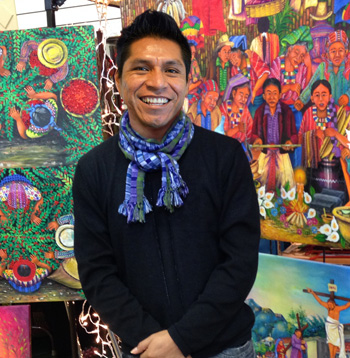Mayan art conveys culture, history and values
Guatemalan Mayan painter Benedicto Ixtamer found that he can use his skills painting to earn a living by selling art to tourists in Guatemala, and at art sales and shows in the United States.
 |
|---|
| Benedicto Ixtamer’s art catches elders’ perspectives, a bird’s eye view. |
His vibrant red, orange, blue, green, yellow and purple paintings capture the people, history, culture, faith and nature of his hometown, San Juan La Laguna, a Mayan community of 10,000 on the shores of Lake Atitlan in the Guatemalan highlands.
His art, like the Mayan textiles his ancestors made for centuries, is full of colorful patterns and indigenous designs.
Benedicto was recently in Spokane for the first time as a new vendor at the Jubilee International Marketplace at First Presbyterian Church.
He learned about that event from Sandi and Brian Thompson Royer, members of Bethany Presbyterian Church in Spokane. They are serving as mission co-workers with the National Evangelical Presbyterian Church of Guatemala. He helped arrange a home stay for them in his home town.
Benedicto’s father wanted him to quit school after the sixth grade to work in the fields picking coffee for $2 a day. His father also had to feed two daughters and six other sons, but the oldest three had continued studies. He told Benedicto, “You have to work so you can eat.”
Benedicto not only found ways to earn money so he could go to school and eventually earn a living as an artist, but now he also helps provide scholarships, so children from poor families can be educated, and he provides jobs through the various steps of creating paintings.
“As a young teen, I worked harder and carried sand, so I could pay 15 quetzales for tuition. I had homework, too,” he said.
After three more years, he wanted to continue studies. Again, his father said, “No,” but Benedicto left home at 17 to live in the city with an older brother.
He carried propane gas and paper to recycle, but he didn’t earn enough, so in 1999 he went home to San Juan La Laguna. Still wanting to study to be a teacher, he walked 15 minutes to school in neighboring San Pedro, a tourist town.
One day while Benedicto was sitting on the porch of his parent’s home, a foreigner stopped and asked the way to San Pedro. Benedicto was going there and said he would walk him there. The man did not speak Spanish, and Benedicto did not speak English. The road was rough. Benedicto told him in Spanish to be careful. The man said the same in English. They learned that when they found a translator in San Pedro.
The tourist asked Benedicto to be his guide for a hike to the volcano. When he finished the hike, the man asked, “How much?” Benedicto realized a walk to the volcano could be a job. The tourist paid him 300 quetzales ($50), a lot of money for him, and then took him to lunch.
Benedicto paid two months tuition, became a tour guide and started to learn some English from friends and tourists. Now he can translate not only from Spanish but also from his native Tz’utujil Mayan language.
In primary school, a teacher had seen that Benedicto enjoyed drawing and asked him to draw the subject for the class and then hang it on the wall. One day, an old woman asked him to paint a mother and child for Mother’s Day. She asks him every year.
“I painted with crayons first and then with oil colors. When I asked my father for oil colors, he gave me three colors, blue, red and yellow. With that, I painted on cardboard and then used my mother’s backstrap weavings as canvas. I kept exploring and building skill painting,” he said.
His father continued to question the value of art.
“I did not know I could make a living with art,” Benedicto said. “I had a wall two meters by three meters filled with paintings. A foreign visitor I guided to the mountain asked to see my paintings, so I took him to my home after a tour. He wanted to buy all the pieces and paid me well.
“He inspired me to make painting my job. My father couldn’t believe it when I sold the paintings,” he said. “I painted more and bought more art supplies.”
Through connections with tourists, he started in 2004 to come to the United States to sell art in art shows.
He still teaches Spanish in a Spanish school run by his family in his hometown, but basically his life is about his art.
In 2005, he went to the university in Xela Quetzaltenago to study communication, radio, TV and newspaper. He did an internship with Mayan TV. He quit for a while, but went back in 2007 and graduated in June 2014.
“I want to do art, write newspaper stories, and tell stories on TV and the radio. Media are also art expressions,” he said.
Now Benedicto and his wife, Maria, who in her early years also worked hard, picking up rocks and filling bags to sell for building, raise funds with friends for scholarships to help 50 children from poor families go to school through graduation. Some are now teachers, accountants and secretaries.
They also coordinate a food program for poor families.
Friends from the United States help buy food so they can provide corn, beans, eggs, rice and other basics. They run a community garden with friends, planting vegetables and harvesting them, so they and others can eat greens.
Their first child, who is now 12, is part of their team. They also have a two-year-old.
“We respect everyone in different religions. In our programs, we do not see religion. We serve anyone,” said Benedicto, who has faith that God will help him through difficulties as God has in the past.
His art production involves and employs more than Maria and him.
“My art is like a string, connecting people who need work,” he said. “I’m happy to sell to people who want to learn about our culture. They provide money, so I can provide more jobs. We all hold hands and work together. I meet many nice people in the process.
“What we need is for the world to work together as a team,” he said, describing some of the different tasks he hires people to do.
• Guatemalan mothers weave the canvas.
• Others make the yarn they use.
• A backstrap loom is just 26 inches wide, so he also involves some weavers who use foot looms.
• Young people come, stretch canvas and staple it on wood frames.
• Carpenters make the frames.
• Benedicto talks with Mayan elders to gain ideas. The Mayan culture is the cornerstone of his art.
“I listen to them as they talk in colors, images and history. I love to capture the history, life and culture of the people in drawings. I take them home and then work in colors to paint.
“Part of our history is not written. The grandfathers, who are 97 to 100, are dying. They tell stories from 1524, stories they heard from their grandfathers. Some ancestors went up the hill to escape the conquistadors. They came back as birds, flying over the town to see what was happening. There are sculptures of birds on roofs. Birds are also guardians watching over and taking care of us.”
Benedicto seeks to capture the history elders share in his art.
In his art, he helps people see from different perspectives, looking at people and culture through a normal, native view, from a bird’s eye view, from a fish view (at an angle) and from an ant’s view.
For example, he explores how a fish would see people from the lake. The sky is the background with the sun at the center. People have big hands and feet.
“God is big and makes things simple and in color. That’s included in my art and expression,” Benedicto said.
To bring paintings to the U.S.. he takes them off the frames, rolling them and putting them in tubes. Then he stretches them to display.
In the U.S., he has shows at galleries, festivals, art shows, corporate headquarters, universities and wherever he makes contacts.
Benedicto spent two weeks in Spokane and then went to Fox Island to meet people who are helping in Guatemala. He was in the United States this time for two months to do sales and networking.
For information, call 563-594-8479, email benedictomayanartist@gmail.com or visit www.benedictomayanartist.org.
Copyright © December 2014 - The Fig Tree




